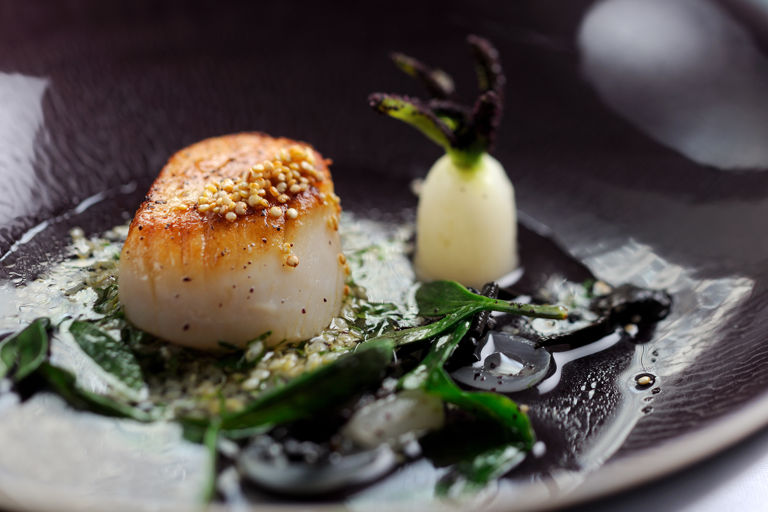Scallop broth
Item 1 of 1
- medium
- 4
- 5 hours
This gourmet scallop recipe from Agnar Sverrisson is a complex starter, both in terms of preparation and flavour. Make sure you are prepared to put in some elbow grease as the pay-off will be worth it.
First published in 2015
discover more:
Ingredients
Metric
Imperial
Crab and bonito nage
- 2 tbsp of oil
- 400g of crab shell, crushed
- 500ml of white wine
- 200g of scallop skirt
- 60g of lemongrass, bruised and chopped
- 1g of xanthan gum
- 5g of salt
- 1 lemon, juiced
- 100ml of bonito vinegar
Vegetable nage
- 4 carrots, roughly chopped
- 4 fennel, roughly chopped
- 1 leek, roughly chopped
- 3 onions, roughly chopped
- 1/2 head of celery, roughly chopped
- 2.5l water
- 15g of salt
- 100g of parsley stalks
- 50g of chervil stalks
Sea aster and sea fennel
- 100g of sea aster
- 100g of sea fennel
Baby mooli
- 3 baby mooli
- 15g of salt
- 500ml of water
Pickle liquor
- 800ml of water
- 100ml of white wine vinegar
- 100ml of pomace oil (1)
- 2g of fennel seeds
- 15g of salt
- 15g of sugar
Pickled baby onions
- 500ml of water
- 15g of salt
- 400g of baby onions
Pickled trompettes
- 200g of trompette mushrooms
SAVE RECIPE
Equipment
- Fine sieve
- Thermometer
Method
2
Bring to a boil, take off the heat and add the parsley and chervil. Cool to room temperature and chill overnight
- 100g of parsley stalks
- 50g of chervil stalks
4
For the fennel dice, bring the water and salt to a boil. Blanch the fennel dice in the water for 2-3 minutes until tender but still with some bite. Refresh in iced water
5
For the pickle liquor, put all the ingredients in a pan and bring to a boil. Take off the heat and leave to infuse for 30 minutes. Pass through a sieve
- 800ml of water
- 100ml of white wine vinegar
- 100ml of pomace oil (1)
- 2g of fennel seeds
- 15g of salt
- 15g of sugar
6
For the pickled trompettes, warm 300ml of the pickling liquor to 70ºC. Use a thermometer to make sure the temperature is right
7
Put the mushrooms into the liquor and allow it to cool to room temperature
- 200g of trompette mushrooms
8
For the pickled baby onions, put the water and salt into a pan and bring to a boil. Blanch the onions for 3-4 minutes until soft but still have some bite. Remove from the pan and halve lengthways
- 500ml of water
- 15g of salt
- 400g of baby onions
9
Put in a pan with 400ml pickle liquor. Bring to a boil, take off the heat and allow to cool to room temperature
10
For the baby mooli, cut each mooli into 3 sections. Bring the salt and water to a boil. Blanch the mooli pieces for 1-2 minutes until tender but still with some bite. Refresh in iced water
- 3 baby mooli
- 500ml of water
- 15g of salt
11
For the sea aster and sea fennel, blanch the sea aster and sea fennel separately in pans of boiling water for 5-10 seconds. Drain and refresh in iced water
- 100g of sea aster
- 100g of sea fennel
12
For the crab and bonito nage, heat the oil in a large pan. Add the crab shells and sweat for 1-2 minutes. Add the white wine and bring to a boil, and cook out for 2-3 minutes
- 2 tbsp of oil
- 400g of crab shell
- 500ml of white wine
13
Add the vegetable nage, bring to the boil, turn down and simmer for 5 minutes. Take off the heat and add the scallop skirts and lemongrass and infuse for 5 minutes. Pass through a fine sieve
- 200g of scallop skirt
- 60g of lemongrass
15
For the roast scallops, open the scallop shells with a sharp knife by sliding the edge into the end where the hinge is
- 4 scallops
16
Carefully remove the roe and muscle and slice the scallop off the shell. Wash in cold water and blot dry. Cover with a damp cloth and chill until needed
17
To finish the scallops, heat the olive oil in a non-stick pan until very hot
- 1 tbsp of olive oil
18
Season the scallops, add to the pan rounded side down and cook for 30 seconds to 1 minute until nicely golden. Turn over, season with lemon juice and lift out of the pan
- 1 lemon, halved
19
Delicately arrange the different elements in the centre of each serving plate, making sure to show off the contrasting colours. Serve immediately
Get in touch
Please sign in or register to send a comment to Great British Chefs.



